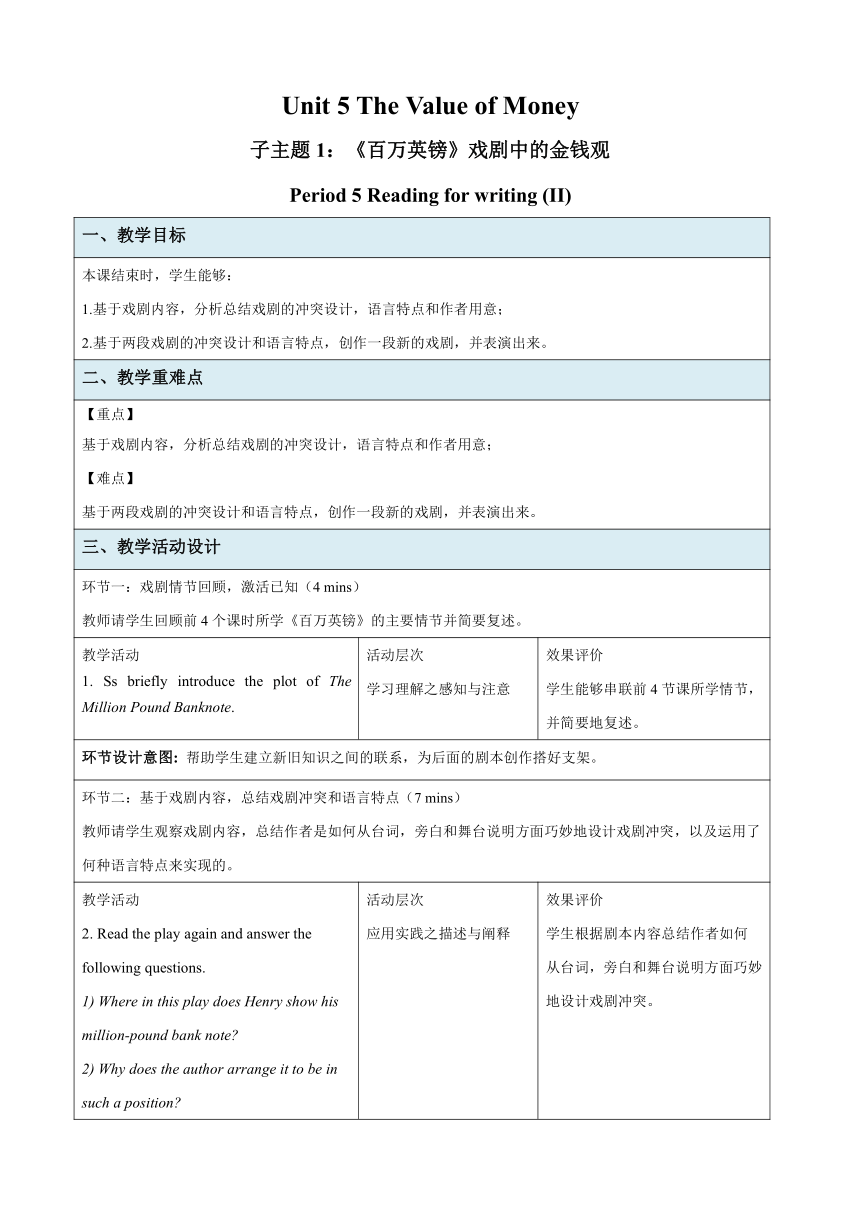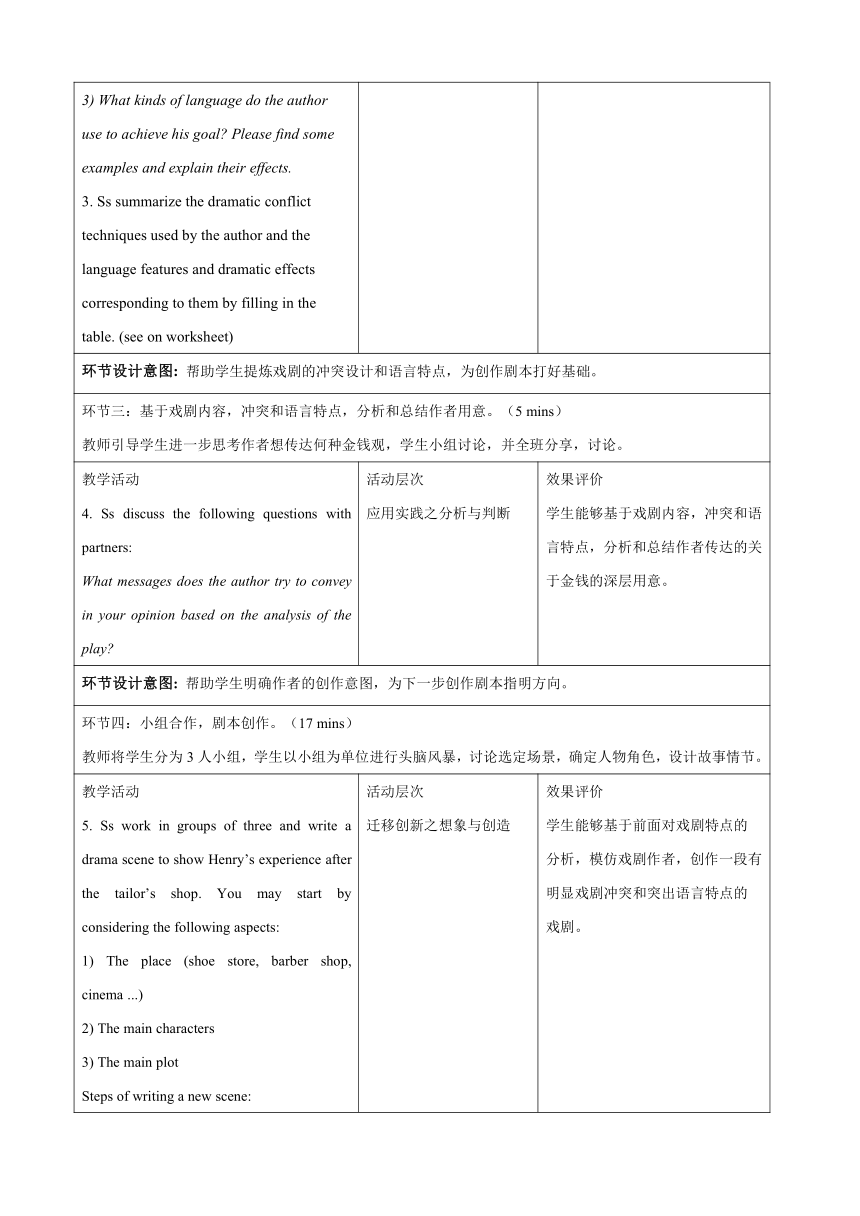人教版(2019)必修第三册Unit 5 The Value of Money Reading for Writing 教学设计 (II)-(表格式)
文档属性
| 名称 | 人教版(2019)必修第三册Unit 5 The Value of Money Reading for Writing 教学设计 (II)-(表格式) |

|
|
| 格式 | docx | ||
| 文件大小 | 21.6KB | ||
| 资源类型 | 教案 | ||
| 版本资源 | 人教版(2019) | ||
| 科目 | 英语 | ||
| 更新时间 | 2024-05-05 21:25:32 | ||
图片预览


文档简介
Unit 5 The Value of Money
子主题1:《百万英镑》戏剧中的金钱观
Period 5 Reading for writing (II)
一、教学目标
本课结束时,学生能够: 1.基于戏剧内容,分析总结戏剧的冲突设计,语言特点和作者用意; 2.基于两段戏剧的冲突设计和语言特点,创作一段新的戏剧,并表演出来。
二、教学重难点
【重点】 基于戏剧内容,分析总结戏剧的冲突设计,语言特点和作者用意; 【难点】 基于两段戏剧的冲突设计和语言特点,创作一段新的戏剧,并表演出来。
三、教学活动设计
环节一:戏剧情节回顾,激活已知(4 mins) 教师请学生回顾前4个课时所学《百万英镑》的主要情节并简要复述。
教学活动 1. Ss briefly introduce the plot of The Million Pound Banknote. 活动层次 学习理解之感知与注意 效果评价 学生能够串联前4节课所学情节,并简要地复述。
环节设计意图: 帮助学生建立新旧知识之间的联系,为后面的剧本创作搭好支架。
环节二:基于戏剧内容,总结戏剧冲突和语言特点(7 mins) 教师请学生观察戏剧内容,总结作者是如何从台词,旁白和舞台说明方面巧妙地设计戏剧冲突,以及运用了何种语言特点来实现的。
教学活动 2. Read the play again and answer the following questions. 1) Where in this play does Henry show his million-pound bank note 2) Why does the author arrange it to be in such a position 3) What kinds of language do the author use to achieve his goal Please find some examples and explain their effects. 3. Ss summarize the dramatic conflict techniques used by the author and the language features and dramatic effects corresponding to them by filling in the table. (see on worksheet) 活动层次 应用实践之描述与阐释 效果评价 学生根据剧本内容总结作者如何从台词,旁白和舞台说明方面巧妙地设计戏剧冲突。
环节设计意图: 帮助学生提炼戏剧的冲突设计和语言特点,为创作剧本打好基础。
环节三:基于戏剧内容,冲突和语言特点,分析和总结作者用意。(5 mins) 教师引导学生进一步思考作者想传达何种金钱观,学生小组讨论,并全班分享,讨论。
教学活动 4. Ss discuss the following questions with partners: What messages does the author try to convey in your opinion based on the analysis of the play 活动层次 应用实践之分析与判断 效果评价 学生能够基于戏剧内容,冲突和语言特点,分析和总结作者传达的关于金钱的深层用意。
环节设计意图: 帮助学生明确作者的创作意图,为下一步创作剧本指明方向。
环节四:小组合作,剧本创作。(17 mins) 教师将学生分为3人小组,学生以小组为单位进行头脑风暴,讨论选定场景,确定人物角色,设计故事情节。
教学活动 5. Ss work in groups of three and write a drama scene to show Henry’s experience after the tailor’s shop. You may start by considering the following aspects: 1) The place (shoe store, barber shop, cinema ...) 2) The main characters 3) The main plot Steps of writing a new scene: Make a list of the characters. Make an outline of the events in the scene. Decide how the characters’ feelings change during the scene. Think of an exciting ending. Write the dialogue. Write the stage directions which tell the actors what to do or how to say something. 活动层次 迁移创新之想象与创造 效果评价 学生能够基于前面对戏剧特点的分析,模仿戏剧作者,创作一段有明显戏剧冲突和突出语言特点的戏剧。
环节设计意图: 引导学生从戏剧的基本结构入手,发挥自身的创造力,创作一段剧本。
环节四:小组表演 (12 mins) 学生以小组为单位排练剧本内容(每段剧本内容不超过4分钟),并全班分享。
教学活动 6. Ss rehearse in their groups and act it out in class. The audience will evaluate the performance based on an evaluation form. 活动层次 迁移创新之批判与评价 效果评价 学生能够将自己编排的戏剧表演出来。
环节设计意图: 帮助学生将自己的戏剧创造力转变为实际的表演,体会戏剧的独特魅力。
作业与拓展学习设计 Polish your dramatic scene and make it into a short video.
Worksheet
Unit 5 Reading for writing (II)
Activity 1: Review and share
Please briefly introduce the plot of The Million Pound Bank Note.
Activity 2: Scan and answer
Read the play again and answer the following questions.
1. Where in this play does Henry show his million-pound bank note
2. Why does the author arrange it to be in such a position
3. What kinds of language does the author use to achieve his goal Please find some examples and explain their effects.
Activity 3: Scan and summarize
Summarize the dramatic conflict techniques used by the author and the language features corresponding to them by filling in the table below.
dramatic conflicts language features dramatic effects
Activity 4: Discuss and share
What messages does the author try to convey in your opinion based on the analysis of the play
Activity 5: Create a dramatic scene
Write a dramatic scene to show Henry’s experience after the tailor’s shop. You may start by considering the following aspects:
1. The place (shoe store, barber shop, cinema...) 2. The main characters 3. The main plot
Steps of writing a new scene:
A. Make a list of the characters.
B. Make an outline of the events in the scene.
C. Decide how the characters’ feelings change during the scene.
D. Think of an exciting ending.
E. Write the dialogue.
F. Write the stage directions which tell the actors what to do or how to say something.
Activity 6: Act it out
Rehearse your dramatic scene in groups of three and then act it out in class. The audience should grade their performance based on the evaluation form.
Evaluation Form
Item Peer-evaluation Teacher-evaluation
Interesting plot ☆ ☆ ☆ ☆ ☆ ☆ ☆ ☆ ☆ ☆
Sharp contrast/dramatic conflict ☆ ☆ ☆ ☆ ☆ ☆ ☆ ☆ ☆ ☆
Language accuracy ☆ ☆ ☆ ☆ ☆ ☆ ☆ ☆ ☆ ☆
Language Fluency ☆ ☆ ☆ ☆ ☆ ☆ ☆ ☆ ☆ ☆
Tones and intonations ☆ ☆ ☆ ☆ ☆ ☆ ☆ ☆ ☆ ☆
Facial expressions/Hand gestures ☆ ☆ ☆ ☆ ☆ ☆ ☆ ☆ ☆ ☆
Time control (within 4 minutes) ☆ ☆ ☆ ☆ ☆ ☆ ☆ ☆ ☆ ☆
Homework:
Polish your dramatic scene and make it into a short video.
子主题1:《百万英镑》戏剧中的金钱观
Period 5 Reading for writing (II)
一、教学目标
本课结束时,学生能够: 1.基于戏剧内容,分析总结戏剧的冲突设计,语言特点和作者用意; 2.基于两段戏剧的冲突设计和语言特点,创作一段新的戏剧,并表演出来。
二、教学重难点
【重点】 基于戏剧内容,分析总结戏剧的冲突设计,语言特点和作者用意; 【难点】 基于两段戏剧的冲突设计和语言特点,创作一段新的戏剧,并表演出来。
三、教学活动设计
环节一:戏剧情节回顾,激活已知(4 mins) 教师请学生回顾前4个课时所学《百万英镑》的主要情节并简要复述。
教学活动 1. Ss briefly introduce the plot of The Million Pound Banknote. 活动层次 学习理解之感知与注意 效果评价 学生能够串联前4节课所学情节,并简要地复述。
环节设计意图: 帮助学生建立新旧知识之间的联系,为后面的剧本创作搭好支架。
环节二:基于戏剧内容,总结戏剧冲突和语言特点(7 mins) 教师请学生观察戏剧内容,总结作者是如何从台词,旁白和舞台说明方面巧妙地设计戏剧冲突,以及运用了何种语言特点来实现的。
教学活动 2. Read the play again and answer the following questions. 1) Where in this play does Henry show his million-pound bank note 2) Why does the author arrange it to be in such a position 3) What kinds of language do the author use to achieve his goal Please find some examples and explain their effects. 3. Ss summarize the dramatic conflict techniques used by the author and the language features and dramatic effects corresponding to them by filling in the table. (see on worksheet) 活动层次 应用实践之描述与阐释 效果评价 学生根据剧本内容总结作者如何从台词,旁白和舞台说明方面巧妙地设计戏剧冲突。
环节设计意图: 帮助学生提炼戏剧的冲突设计和语言特点,为创作剧本打好基础。
环节三:基于戏剧内容,冲突和语言特点,分析和总结作者用意。(5 mins) 教师引导学生进一步思考作者想传达何种金钱观,学生小组讨论,并全班分享,讨论。
教学活动 4. Ss discuss the following questions with partners: What messages does the author try to convey in your opinion based on the analysis of the play 活动层次 应用实践之分析与判断 效果评价 学生能够基于戏剧内容,冲突和语言特点,分析和总结作者传达的关于金钱的深层用意。
环节设计意图: 帮助学生明确作者的创作意图,为下一步创作剧本指明方向。
环节四:小组合作,剧本创作。(17 mins) 教师将学生分为3人小组,学生以小组为单位进行头脑风暴,讨论选定场景,确定人物角色,设计故事情节。
教学活动 5. Ss work in groups of three and write a drama scene to show Henry’s experience after the tailor’s shop. You may start by considering the following aspects: 1) The place (shoe store, barber shop, cinema ...) 2) The main characters 3) The main plot Steps of writing a new scene: Make a list of the characters. Make an outline of the events in the scene. Decide how the characters’ feelings change during the scene. Think of an exciting ending. Write the dialogue. Write the stage directions which tell the actors what to do or how to say something. 活动层次 迁移创新之想象与创造 效果评价 学生能够基于前面对戏剧特点的分析,模仿戏剧作者,创作一段有明显戏剧冲突和突出语言特点的戏剧。
环节设计意图: 引导学生从戏剧的基本结构入手,发挥自身的创造力,创作一段剧本。
环节四:小组表演 (12 mins) 学生以小组为单位排练剧本内容(每段剧本内容不超过4分钟),并全班分享。
教学活动 6. Ss rehearse in their groups and act it out in class. The audience will evaluate the performance based on an evaluation form. 活动层次 迁移创新之批判与评价 效果评价 学生能够将自己编排的戏剧表演出来。
环节设计意图: 帮助学生将自己的戏剧创造力转变为实际的表演,体会戏剧的独特魅力。
作业与拓展学习设计 Polish your dramatic scene and make it into a short video.
Worksheet
Unit 5 Reading for writing (II)
Activity 1: Review and share
Please briefly introduce the plot of The Million Pound Bank Note.
Activity 2: Scan and answer
Read the play again and answer the following questions.
1. Where in this play does Henry show his million-pound bank note
2. Why does the author arrange it to be in such a position
3. What kinds of language does the author use to achieve his goal Please find some examples and explain their effects.
Activity 3: Scan and summarize
Summarize the dramatic conflict techniques used by the author and the language features corresponding to them by filling in the table below.
dramatic conflicts language features dramatic effects
Activity 4: Discuss and share
What messages does the author try to convey in your opinion based on the analysis of the play
Activity 5: Create a dramatic scene
Write a dramatic scene to show Henry’s experience after the tailor’s shop. You may start by considering the following aspects:
1. The place (shoe store, barber shop, cinema...) 2. The main characters 3. The main plot
Steps of writing a new scene:
A. Make a list of the characters.
B. Make an outline of the events in the scene.
C. Decide how the characters’ feelings change during the scene.
D. Think of an exciting ending.
E. Write the dialogue.
F. Write the stage directions which tell the actors what to do or how to say something.
Activity 6: Act it out
Rehearse your dramatic scene in groups of three and then act it out in class. The audience should grade their performance based on the evaluation form.
Evaluation Form
Item Peer-evaluation Teacher-evaluation
Interesting plot ☆ ☆ ☆ ☆ ☆ ☆ ☆ ☆ ☆ ☆
Sharp contrast/dramatic conflict ☆ ☆ ☆ ☆ ☆ ☆ ☆ ☆ ☆ ☆
Language accuracy ☆ ☆ ☆ ☆ ☆ ☆ ☆ ☆ ☆ ☆
Language Fluency ☆ ☆ ☆ ☆ ☆ ☆ ☆ ☆ ☆ ☆
Tones and intonations ☆ ☆ ☆ ☆ ☆ ☆ ☆ ☆ ☆ ☆
Facial expressions/Hand gestures ☆ ☆ ☆ ☆ ☆ ☆ ☆ ☆ ☆ ☆
Time control (within 4 minutes) ☆ ☆ ☆ ☆ ☆ ☆ ☆ ☆ ☆ ☆
Homework:
Polish your dramatic scene and make it into a short video.
